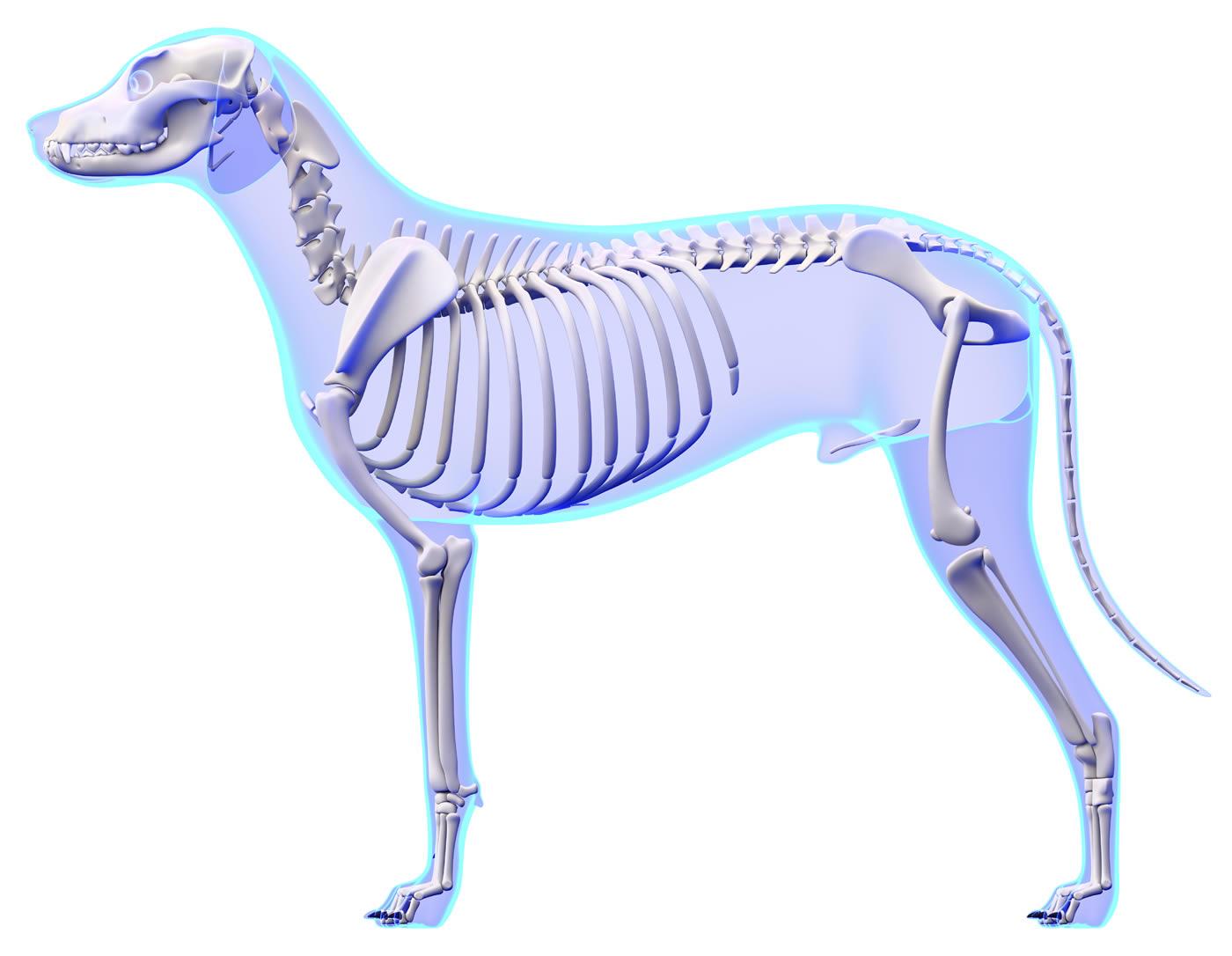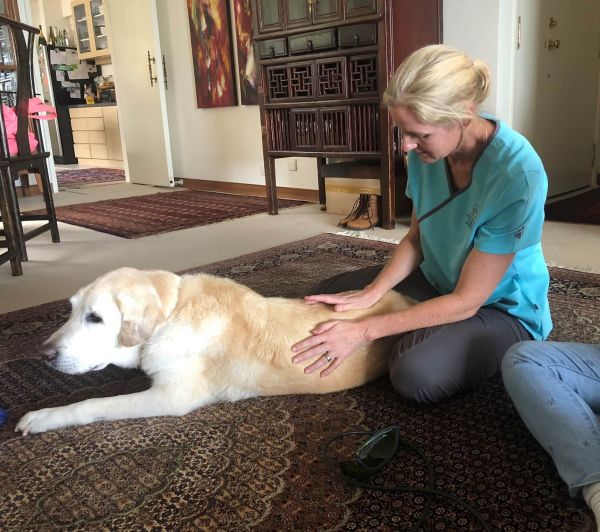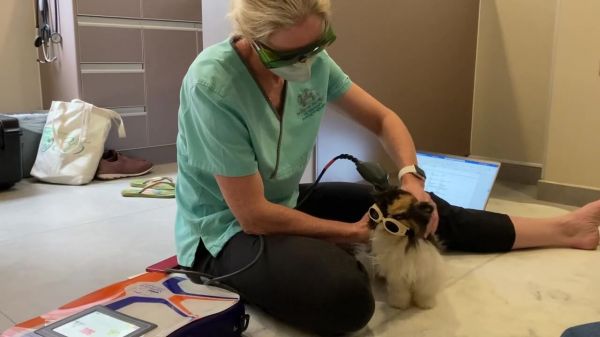
Joints, Bones and Post-Surgery Rehabilitation

Veterinary treatment includes exercise, weight loss, anti-inflammatory drugs, surgery, physiotherapy and rehabilitation. Physiotherapy improves patient comfort and recovery after injury, helping them to return to their active lifestyle faster.
Young growing pets
Hip and elbow dysplasia are common conditions in many growing dogs and cats. Dysplasia simply means where the bones of a joint do not match up properly. Other bone and joint problems in growing pets include patella luxation, where the knee-cap pops in and out of the groove; and osteochondrosis dissecans (OCD) which is a separation of the cartilage from the bone. All these conditions can be very painful during a pet’s growing phase and can easily progress to joint osteoarthritis.
Osteoarthritis and degenerative conditions
Across the pet population, one of the most common joint problems is osteoarthritis (OA), also known as degenerative joint disease (DJD). This is a long-term and progressive deterioration of joint cartilage and structures with ongoing inflammation. OA and DJD can develop at any age, even young pets. OA has been shown to affect up to 20% of dogs over the age of one year, and 4 in 5 adult dogs; while another study showed 90% of cats over the age of 12 years had some form of OA.
Common injuries
There are also several joint issues that occur from trauma or injury. While surgery is usually a requirement for catastrophic injuries such as fractures or ligament damage like cranial cruciate ligament rupture (CCLR), surgery is also sometimes required for more serious joint conditions. We help rehabilitate pets after total hip replacement (THR), medial patella luxation (MPL), femoral head and neck excision (FHNE), surgery for cruciate repair (TPLO/ TTA) and arthrodesis or fusing the joint.
These different joint conditions can cause pain, weakness, decreased range of motion and flexibility, reduced strength and endurance and difficulties with normal activities.

Joint and bone conditions can cause significant pain and weakness. Lameness and limping or ‘strange’ walking, movement and difficulties with normal activities are common signs, depending on the severity and how many joints or legs are affected.
When our furry friends feel pain, they most often show changes in behaviour. Watch for changes in behaviours, responses and appearances of your pet to identify pain and discomfort rather than focusing on a single aspect, such as vocalisation. Changes in daily activity, grooming, interactions, habits, changes in appearance (body position and facial expressions), are indications that something is going on and needs to be investigated.
For treatment of chronic conditions, an early diagnosis means that measures to reduce the progress of the disease can be put in place. Look out for early signs including:
This site is protected by reCAPTCHA and the Google Privacy Policy and Terms of Service apply.
All our therapies are non-painful and non-invasive. Therapies vary depending on your pet, their needs and condition.

Many specialised ‘hands-on’ techniques are used by our veterinary therapists to assess and treat soft tissue & muscle tightness, joint restrictions, and range of motion. Therapeutic massage is also used to treat muscle tension and tightness which occur secondary to joint and bone problems.
More about Manual Therapy
Therapeutic laser uses invisible infrared light energy (photons) to penetrate deep into tissues and enhance tissue healing. Laser therapy can be used to help rehabilitate patients with musculoskeletal pain, tissue swelling, inflammation, joint pain, fracture healing, osteoarthritis and also to deliver laser-puncture (acupuncture via laser).
More about Laser Therapy
Whilst your veterinary surgeon may prescribe a combination of medication to alleviate pain; physiotherapy allows us to combine several additional therapies, techniques and modalities to further reduce and manage pain.
More about Pain management
Exercises are designed specifically for each patient. Important factors to be considered include the type of tissues involved, joints affected, surgical procedure (if any), age and species of the pet, stage of tissue repair and the ability of the pet. Various different dog training equipment is utilised to match your pet’s needs and ability. Exercises may include passive and active stretching, balance and core work and strengthening of specific muscle groups, followed by endurance training for body fitness.
Many of the exercises are designed to be continued at home to encourage you to be actively involved in your pet’s rehabilitation and help them to recover faster.
More About Therapeutic Exercise
PEMF is used to generate low level electrical fields in the body, which target the bodies anti-inflammatory process to aid in tissue repair and pain relief. PEMF is used after surgery, in fracture healing and in joint disease (acute and chronic conditions like osteoarthritis) to reduce swelling (oedema) and inflammation, and as a result, control pain.
More about PEMF
Joint supplements with key ingredients of glucosamine, chondroitin and Omega-3 fatty acids, such as those available in bioactive green lipped muscle and deer velvet, can help to repair damage to the cells in the body and are extremely useful in improving joint health and comfort, as well as helping to protect the joint structures from wear and tear.
Buy Supplements
Cryotherapy, or cold therapy, is used to reduce the inflammatory response and provide pain relief, while in contrast, warmth/ heat therapy is avoided in acute inflammation and instead helps with muscle relaxation, removal of toxins and reduces joint stiffness.
More about Thermal therapy
The Stance Analyser quantifies your dog’s weight distribution through each leg to provide an accurate reading and removes the guesswork involved. The readings help to identify problem areas as part of the physiotherapy consultation and we can monitor your pets' ongoing therapy and response. This is a fast, simple and non-invasive way to monitor your pet’s stance.
More about Stance AnalyserOur process for joint, bone and post-surgery problems
Initially we need to collect as much information as possible about your pet and your concerns; we will send you a detailed online questionnaire to complete. We will also reach out to your family veterinarian and /or specialist for your pet’s full medical history.
At our physiotherapy initial consultation, we assess the gait and movement of your pet, review the medical history and perform a thorough physical assessment to determine which parts of their neurological and musculoskeletal systems are affected.
Working together with you, we then devise a physiotherapy and rehabilitation treatment plan which meets the needs and goals of your individual pet. The treatment plan will generally include a variety of therapies and home care for you to continue at home, alongside our treatments.
Regular physiotherapy re-assessments are made throughout the treatment period to ensure your pet is progressing well with their rehabilitation and to update any home exercises prescribed. The frequency varies depending on your pet’s needs.
"Dr. Jane and her team has been so supportive making the post-surgery recovery period so much more copable"
"I’m happy she recovered quickly and is back to her active self."
HK$ 2880
HK$ 2580
HK$ 1140
HK$ 520


